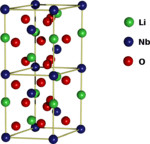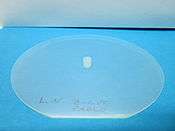Lithium niobate
 | |
| Identifiers | |
|---|---|
| 12031-63-9 | |
| 3D model (Jmol) | Interactive image |
| ChemSpider | 10605804 |
| ECHA InfoCard | 100.031.583 |
| PubChem | 159404 |
| |
| |
| Properties | |
| LiNbO3 | |
| Molar mass | 147.846 g/mol |
| Appearance | colorless solid |
| Density | 4.65 g/cm3 [1] |
| Melting point | 1,257 °C (2,295 °F; 1,530 K)[1] |
| None | |
| Band gap | 4 eV |
| Refractive index (nD) |
no 2.30, ne 2.21[2] |
| Structure | |
| trigonal | |
| R3c | |
| 3m (C3v) | |
| Hazards | |
| Lethal dose or concentration (LD, LC): | |
| LD50 (median dose) |
8000 mg/kg (oral, rat)[3] |
| Except where otherwise noted, data are given for materials in their standard state (at 25 °C [77 °F], 100 kPa). | |
| | |
| Infobox references | |
Lithium niobate (LiNbO3) is a compound of niobium, lithium, and oxygen. Its single crystals are an important material for optical waveguides, mobile phones, piezoelectric sensors, optical modulators and various other linear and non-linear optical applications.
Properties
Lithium niobate is a colorless solid insoluble in water. It has a trigonal crystal system, which lacks inversion symmetry and displays ferroelectricity, Pockels effect, piezoelectric effect, photoelasticity and nonlinear optical polarizability. Lithium niobate has negative uniaxial birefringence which depends slightly on the stoichiometry of the crystal and on temperature. It is transparent for wavelengths between 350 and 5200 nanometers.
Lithium niobate can be doped by magnesium oxide, which increases its resistance to optical damage (also known as photorefractive damage) when doped above the optical damage threshold. Other available dopants are Fe, Zn, Hf, Cu, Gd, Er, Y, Mn and B.
Growth
Single crystals of lithium niobate can be grown using the Czochralski process.[4]

After a crystal is grown, it is sliced into wafers of different orientation. Common orientations are Z-cut, X-cut, Y-cut, and cuts with rotated angles of the previous axes.[5]
Nanoparticles
Nanoparticles of lithium niobate and niobium pentoxide can be produced at low temperature.[6] The complete protocol implies a LiH induced reduction of NbCl5 followed by in situ spontaneous oxidation into low-valence niobium nano-oxides. These niobium oxides are exposed to air atmosphere resulting in pure Nb2O5. Finally, the stable Nb2O5 is converted into lithium niobate LiNbO3 nanoparticles during the controlled hydrolysis of the LiH excess.[7] Spherical nanoparticles of lithium niobate with a diameter of approximately 10 nm can be prepared by impregnating a mesoporous silica matrix with a mixture of an aqueous solution of LiNO3 and NH4NbO(C2O4)2 followed by 10 min heating in an IR furnace.[8]
Applications
Lithium niobate is used extensively in the telecoms market, e.g. in mobile telephones and optical modulators.[9] It is the material of choice for the manufacture of surface acoustic wave devices. For some uses it can be replaced by lithium tantalate, LiTaO3. Other uses are in laser frequency doubling, nonlinear optics, Pockels cells, optical parametric oscillators, Q-switching devices for lasers, other acousto-optic devices, optical switches for gigahertz frequencies, etc. It is an excellent material for manufacture of optical waveguides.
It's also used in the making of optical spatial low-pass (anti-aliasing) filters.
Periodically-poled lithium niobate (PPLN)
Periodically-poled lithium niobate (PPLN) is a domain-engineered lithium niobate crystal, used mainly for achieving quasi-phase-matching in nonlinear optics. The ferroelectric domains point alternatively to the +c and the −c direction, with a period of typically between 5 and 35 µm. The shorter periods of this range are used for second harmonic generation, while the longer ones for optical parametric oscillation. Periodic poling can be achieved by electrical poling with periodically structured electrode. Controlled heating of the crystal can be used to fine-tune phase matching in the medium due to a slight variation of the dispersion with temperature.
Periodic poling uses the largest value of lithium niobate's nonlinear tensor, d33 = 27 pm/V. Quasi-phase matching gives maximum efficiencies that are 2/π (64%) of the full d33, about 17 pm/V.
Other materials used for periodic poling are wide band gap inorganic crystals like KTP (resulting in periodically poled KTP, PPKTP), lithium tantalate, and some organic materials.
The periodic poling technique can also be used to form surface nanostructures.[10][11]
However, due to its low photorefractive damage threshold, PPLN only finds limited applications: at very low power levels. MgO-doped lithium niobate is fabricated by periodically-poled method. Periodically-poled MgO-doped lithium niobate (PPMgOLN) therefore expands the application to medium power level.
Sellmeier equations
The Sellmeier equations for the extraordinary index are used to find the poling period and approximate temperature for quasi-phase matching. Jundt[12] gives
valid from 20 to 250 °C for wavelengths from 0.4 to 5 micrometers, whereas for longer wavelength,[13]
which is valid for T = 25 to 180 °C, for wavelengths λ between 2.8 and 4.8 micrometers.
In these equations f = (T − 24.5)(T + 570.82), λ is in micrometers, and T is in °C.
More generally for ordinary and extraordinary index for MgO-doped LiNbO3:
,
with:
| Parameters | 5% MgO-doped CLN | 1% MgO-doped SLN | |
|---|---|---|---|
| ne | no | ne | |
| a1 | 5.756 | 5.653 | 5.078 |
| a2 | 0.0983 | 0.1185 | 0.0964 |
| a3 | 0.2020 | 0.2091 | 0.2065 |
| a4 | 189.32 | 89.61 | 61.16 |
| a5 | 12.52 | 10.85 | 10.55 |
| a6 | 1.32×10−2 | 1.97×10−2 | 1.59×10−2 |
| b1 | 2.860×10−6 | 7.941×10−7 | 4.677×10−7 |
| b2 | 4.700×10−8 | 3.134×10−8 | 7.822×10−8 |
| b3 | 6.113×10−8 | −4.641×10−9 | −2.653×10−8 |
| b4 | 1.516×10−4 | −2.188×10−6 | 1.096×10−4 |
for congruent LiNbO3 (CLN) and stochiometric LiNbO3 (SLN).[14]
See also
References
- 1 2 Spec sheet of Crystal Technology, Inc.
- ↑ "Luxpop". Retrieved June 18, 2010. (Value at nD=589.2 nm, 25 °C.)
- ↑ http://chem.sis.nlm.nih.gov/chemidplus/rn/12031-63-9
- ↑ Volk, Tatyana; Wohlecke, Manfred (2008). Lithium Niobate: Defects, Photorefraction and Ferroelectric Switching. Springer. pp. 1–9. doi:10.1007/978-3-540-70766-0. ISBN 978-3-540-70765-3.
- ↑ Wong, K. K. (2002). Properties of Lithium Niobate. London, United Kingdom: INSPEC. p. 8. ISBN 0 85296 799 3.
- ↑ Grange, R.; Choi, J.W.; Hsieh, C.L.; Pu, Y.; Magrez, A.; Smajda, R.; Forro, L.; Psaltis, D. (2009). "Lithium niobate nanowires: synthesis, optical properties and manipulation". Applied Physics Letters. 95 (14): 143105. Bibcode:2009ApPhL..95n3105G. doi:10.1063/1.3236777.
- ↑ Aufray M, Menuel S, Fort Y, Eschbach J, Rouxel D, Vincent B (2009). "New Synthesis of Nanosized Niobium Oxides and Lithium Niobate Particles and Their Characterization by XPS Analysis". Journal of Nanoscience and Nanotechnology. 9 (8): 4780–4789. doi:10.1166/jnn.2009.1087.
- ↑ Grigas, A; Kaskel, S (2011). "Synthesis of LiNbO3 nanoparticles in a mesoporous matrix". Beilstein Journal of Nanotechnology. 2: 28–33. doi:10.3762/bjnano.2.3. PMC 3045940
 . PMID 21977412.
. PMID 21977412. - ↑ Toney, James (2015). Lithium Niobate Photonics. Artech House. ISBN 978-1-60807-923-0.
- ↑ S. Grilli; P. Ferraro; P. De Natale; B. Tiribilli; M. Vassalli (2005). "Surface nanoscale periodic structures in congruent lithium niobate by domain reversal patterning and differential etching". Applied Physics Letters. 87 (23): 233106. Bibcode:2005ApPhL..87w3106G. doi:10.1063/1.2137877.
- ↑ P. Ferraro; S. Grilli (2006). "Modulating the thickness of the resist pattern for controlling size and depth of submicron reversed domains in lithium niobate". Applied Physics Letters. 89 (13): 133111. Bibcode:2006ApPhL..89m3111F. doi:10.1063/1.2357928.
- ↑ Dieter H. Jundt (1997). "Temperature-dependent Sellmeier equation for the index of refraction in congruent lithium niobate". Optics Letters. 22 (20): 1553–5. Bibcode:1997OptL...22.1553J. doi:10.1364/OL.22.001553. PMID 18188296.
- ↑ LH Deng; et al. (2006). "Improvement to Sellmeier equation for periodically poled LiNbO3 crystal using mid-infrared difference-frequency generation". Optics Communications. 268 (1): 110. Bibcode:2006OptCo.268..110D. doi:10.1016/j.optcom.2006.06.082.
- ↑ O.Gayer; et al. (2008). "Temperature and wavelength dependent refractive index equations for MgO-doped congruent and stoichiometric LiNbO3". Appl. Phys. B. 91 (2): 343–348. Bibcode:2008ApPhB..91..343G. doi:10.1007/s00340-008-2998-2.
Further reading
- Ferraro, Pietro; Grilli, Simonetta; De Natale, Paolo (eds.). Ferroelectric Crystals for Photonic Applications Including Nanoscale Fabrication and Characterization Techniques. Springer Series in Materials Science. 91. doi:10.1007/978-3-540-77965-0.